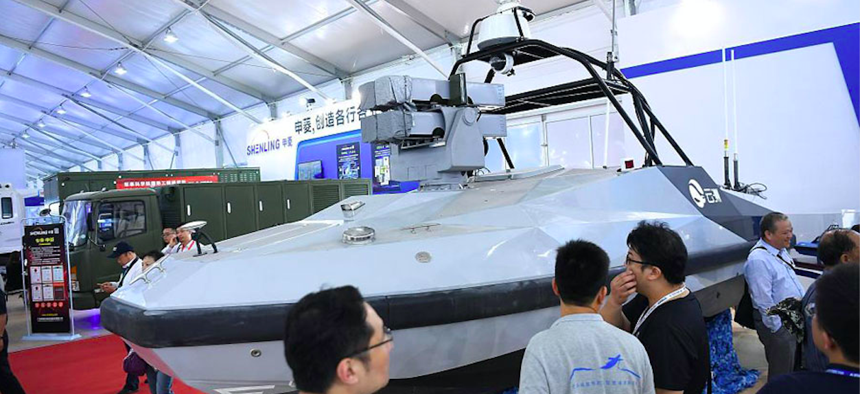
Liaowangzhe-2 is shown at the 12th China International Aviation and Aerospace Exhibition in Zhuhai, South China's Guangdong province, Nov 6, 2018. Photo by VGC via China Daily
China Shows Off Self-Steering Boat that Fires Missiles
But the U.S. still appears to have the edge in sophisticated seagoing drones.
China has developed an autonomous boat that can conduct reconnaissance and fire up to four guided missiles, state-run media reported. Manufactured by Zhuhai Yunzhou Intelligence Technology, the 7.5-meter, 3.7-ton Liaowangzhe-2 was displayed for the first time at the China International Aviation and Aerospace Exhibition in Zhuhai, in southern China this week.
Operating autonomously or by remote control, Liaowangzhe-2 appears similar in function to to Israel’s Protector, which in March 2017 became the first unmanned boat to fire a missile, and which tested its capabilities against naval swarm threats with NATO earlier this week.
State-run media reported that China test-fired the boat’s missiles in October. The missiles have a range of up to 5 kilometers, project director Su Zhen told Global Times, but the boat’s real strengths are its stealth and its 45-knot speed. Su also said a human would make any decisions to fire a missile, even when the boat was operating autonomously.
Related: China, Russia, and the US Are All Building Centers for Military AI
Related: China’s Robot Subs Will Lean Heavily on AI: Report
Related: In AI, Russia Is Hustling to Catch Up
China has been developing its unmanned naval capabilities, such as artificially intelligent submarines, primarily for patrol missions.
U.S. Vs. Chinese Roboboats
The U.S. has been the leader in highly autonomous ocean vessels since August 2014, when the Office of Naval Research staged a breakthrough demonstration on Virginia’s James River. Some 13 self-driving boats conducted a series of complex, coordinated maneuvers to protect a high-value ship and harass enemy vessels. Unlike aerial drones such as the Reaper that still require a human operator, the small rigid-hulled inflatable boats handled advanced swarming tricks with virtually no human guidance. The whole coordinated maneuver drill required just one person, who relayed targeting information from a helicopter.
What goes into a robotic boat? In the ones used in the 2014 test, very little. Their brains consisted of a small, easily produced computer dubbed the Control Architecture for Robotic Agent Command and Sensing, or CARACaS.
“Any boat can be fitted with a kit that allows it to act autonomously and swarm on a potential threat,” Adm. Matthew Klunder, then the head of the Office of Naval Research, said in a press conference.
In 2016, Navy testers followed up with a demonstration that proved the boats could identify threats — no human necessary.
The Defense Advanced Research Projects Agency, or DARPA, followed the Navy’s experiment with a 2015 demonstration of a very different sort of robot boat: a 42-foot self-driving vessel that showed it could conduct autonomous maneuvers while following the Convention on the International Regulations for Preventing Collisions at Sea, essentially the naval laws that govern how ships are to behave on the open water. It was part of a program to develop a 132-foot autonomous ship for the high seas, now a Navy program called Sea Hunter.
“We might be able to put a six-pack or a four-pack of missiles on them. Now, imagine 50 of these distributed and operating together under the hands of a flotilla commander,” former Deputy Defense Secretary Bob Work said in April at a CNAS event. “This is going to be a Navy unlike any navy in history, a human-machine collaborative battle fleet that will confound our enemies.”



